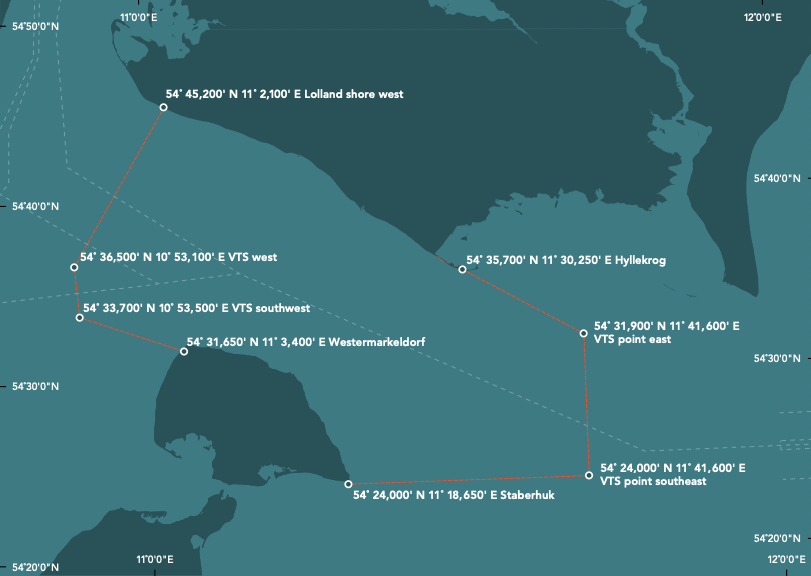
About the project
With a length of 18 km, the Fehmarnbelt Tunnel will be the longest immersed tunnel in the world. It will connect Denmark and Germany and consequently Scandinavia to Central Europe.
The Fehmarnbelt Tunnel will significantly improve the mobility of businesses, offer greater opportunities for leisure travellers, cross-border shoppers and all other travellers on both sides of the Fehmarnbelt. The journey through the tunnel will take 10 minutes by car and 7 minutes by train.

About the project
The fixed link will close a gap in the railway network between Scandinavia and Central Europe. It will boost rail travel and the share of rail freight transport will grow.
First a tunnel trench will be dredged to place the tunnel elements. The construction of the tunnel elements will take place at a large factory in Rødbyhavn and the nearby work harbour. The materials for casting the tunnel elements are shipped to the factory with the finished tunnel elements floated out to sea for installation in the Fehmarnbelt.
Construction activities
The offshore construction activities for establishment of the Fehmarnbelt fixed link as an immersed tunnel will commence in July 2021 and continue until 2027.
The offshore construction works will take place along the future tunnel alignment connecting Denmark (Rødby) and Germany (Puttgarden). Once construction of the immersed tunnel is completed, the water depth will be as today and navigational conditions in Fehmarnbelt will return to normal.

Ship traffic during the construction phase
The offshore construction activities will take place inside two work areas. Work areas are established as restricted areas and access to the work areas is only permitted for the vessels involved in the construction work.
The size of a work area (minimum or nominal) depends on its geographical location. The work areas will be shifted according to the work progress.
For the traffic on route T there will be no restrictions. The location of the sailing routes remain unchanged. However, during the construction phase sailing routes on route T must be planned around the work areas and consider traffic of construction vessels

Ship traffic during the construction phase
The Notice to Mariners and VTS (Vessel Traffic Service) will, in due time, inform the traffic on route T about all changes in the navigation conditions.
A large work harbour is constructed east of Rødbyhavn and a smaller work harbour is constructed east of Puttgarden. The traffic with construction vessels between the work harbours and the work areas along the tunnel alignment will be kept east of the tunnel alignment.
The work areas are marked by special marker buoys. The current positions of the work areas are published via the official Nautical Information Services of the Maritime Authorities (e.g. Notice to Mariners, NAVTEX, VTS).
All ships are advised to ensure that their charts are updated when approaching the construction area.
Light character
Fl(3)Y.10s for the northern work area
All lights are synchronised within each work area.
Fl(2+1)Y.15s for the southern work area
The buoys of the work areas will be physical AIS-AtoN
Fl(1)Y.10s for the holding area
Height above water level: APPROX. 4 METER
"Entire construction period: Average number of movements from work vessels will be around 4 per hour."
Work vessels
Barges under tow, travelling between the work areas and the reclamation areas, will transport the dredged material. Apart from the traffic with barges under tow, a number of small construction vessels (e.g. tugs, survey launches, multicats and personnel transfer vessels) will sail between the construction harbours and the work areas along the tunnel alignment. Part of this traffic will cross route T.
When the trench is ready, 89 tunnel elements, each 217 metres long, are immersed into the trench, one at a time.
The tunnel elements will be towed, in a configuration with minimum four tugs, from the work harbour on Lolland to the working areas at the immersion location. Around half of the towed tunnel elements will cross route T.

"2024-2026: Average number of movements with tunnel elements towed from the work harbour to the work areas will be 1 per 2 weeks."
Navigation safety measures
Central to ensuring the safety and efficiency of the ship traffic is the establishment and operation of a Vessel Traffic Service (VTS Fehmarnbelt).

"ALL SHIPS ENTERING THE VTS AREA ARE REQUESTED TO REPORT TO “FEHMARNBELT TRAFFIC” ON VHF CHANNEL 68."
Assistance Tug
A dedicated assistance tug (Fairplay 30 / Fairplay 31) will be available to assist a hampered or damaged vessel inside the VTS area at all times.
The assistance tug is free of charge, ensured and no salvage or assistance fees will be claimed. The demand of the tug by shipping should be addressed to VTS Fehmarnbelt.

Guard Vessels
Each work area will be guarded by one guard vessel at all times. Representatives from the German and Danish authorities are onboard the guard vessels, and the guard vessels will be acting under the authority of the VTS operators.

The names of the guard vessels:
- M/V Advancer
- M/V Booster
- M/V Arriver
- M/V Builder
Here you can download the flyer about the construction of the Fehmarnbelt Tunnel
Select the language you want:
